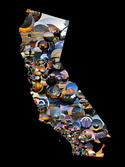Not long ago, Brazil was riding high. It was feted as one of the “BRIC” nations destined to be the next world economic powers. The commodities boom had its natural resources and agricultural sectors humming. The press – for example, Monocle magazine’s swooning over Brazil’s push to boost its diplomatic presence – was adoring. And Rio was awarded the 2014 World Cup and the 2016 Olympics, two events that were intended to both serve as a catalyst for further development, and also as a coming out party of sorts for the country. read more »
Newgeography.com - Economic, demographic, and political commentary about places
America's New Industrial Boomtowns
David Peebles works in a glass tower across from Houston’s Galleria mall, a cathedral of consumption, but his attention is focused on the city’s highly industrialized ship channel 30 miles away. “Houston is the Chicago of this era,” says Peebles, who runs the Texas office of Odebrecht, a $45 billion engineering firm based in Brazil. “In the sixties you had to go to Chicago, Cleveland and Detroit. Now Houston is the place for new industry.” read more »
Composite Traffic Congestion Index Shows Richmond Best
It is important that traffic congestion be controlled sufficiently to facilitate a more competitive metropolitan economy. Each year, three organizations produce traffic congestion reports, Tom Tom, INRIX and the Texas Transportation Institute of Texas A&M University (TTI). These reports use different methods to estimate the excess time lost in traffic congestion during peak travel periods (morning and evening week day "rush hours"). read more »
Let’s Make Kalamazoo’s Promise America’s Promise
In 2005, in order to boost their city’s economy, a small group of donors in the city Glenn Miller made famous created the Kalamazoo Promise. It offered any graduate of the city’s public schools a four-year scholarship covering all tuition and mandatory fees at any of Michigan’s public colleges or universities, provided those students maintained a 2.0 grade average in college and made regular progress toward a degree. read more »
- Login to post comments
The Ugly City Beautiful: A Policy Analysis
When it comes to the future, Detroit and San Francisco act as poles in the continuum of American consciousness. Detroit is dead and will continue dying. San Francisco is the region sipping heartily from the fountain of youth. Such trajectories, according to experts, will go on indefinitely.
Harvard economist Ed Glaeser has a grim outlook for the Rust Belt. “[P]eople and firms are leaving Buffalo for the Sunbelt because the Sunbelt is a warmer, more pleasant, and more productive area to live,” he writes in City Journal.
Glaeser echoes this sentiment in a recent interview with International Business Times, saying “[s]mart people want to be around other smart people”, and the Rust Belt has a long slog ahead given that “post-industrial city migration is dominated by people moving to warmer climes”.
But is this true? read more »
California's Choice - Growth or Decline
I’ve been friends with Charlie Sena for almost two decades. Charlie, a longtime entrepreneur, Democratic political operative and fundraiser for former Gov. Gray Davis, recently chided me about what he sees as my “negativity” about California and its future. My response was that, given its natural advantages, this region should not be in such a weakened condition. Decline, I suggest, is not an imperative here, but largely a choice. read more »
Bulgari to Taco Bell: Across China, Buyers Are the Target
I work for myself, and when I travel to China on business I have the “luxury” of sleeping on trains and in hostels, and getting around during the day by bicycle. This spring I made a circuit from Beijing to Chengdu (in western China), to Wuhan (right in the middle), and to Shanghai (east coast), before heading back to Beijing. Ostensibly I was there to hunt down consumer trends. read more »
Florida: When Density is Destructive
Brick streets, mature old oaks, and a sense of history imbue Winter Park, Florida with a sense of place that is the envy of many small cities and towns. The tony Park Avenue brings shoppers and visitors, who soak up its ambience and enjoy the street life of this quaint southern town. On the east side, bounded by blue lakes, lie gentrified historical mansions, while the west side is a neighborhood of smaller, affordable homes with multigenerational Winter Parkers. read more »
- Login to post comments
The Long Term: Metro America Goes From 82% to 86% Suburban Since 1990
The major metropolitan areas of the United States experienced virtually all of their overall growth in suburban and exurban areas between 2000 and 2010. This is the conclusion of an analysis of the functional Pre-Auto Urban Cores and functional suburban and exurban areas using the Demographia City Sector Model. read more »
- Login to post comments
Columbus, Know Thyself
What Is Your Ambition?
Columbus doesn’t have a powerful brand in the market outside of Ohio. Having said that, the city is growing rapidly in population and jobs, is extremely livable and improving day by day, and seems to make its residents very happy. Is there any reason the city has to be better nationally known in order to be complete or something?
I say No. It’s a valid choice to simply stay with the status quo. read more »






















